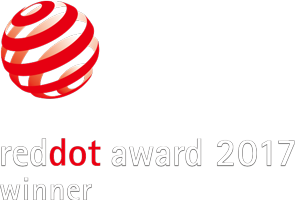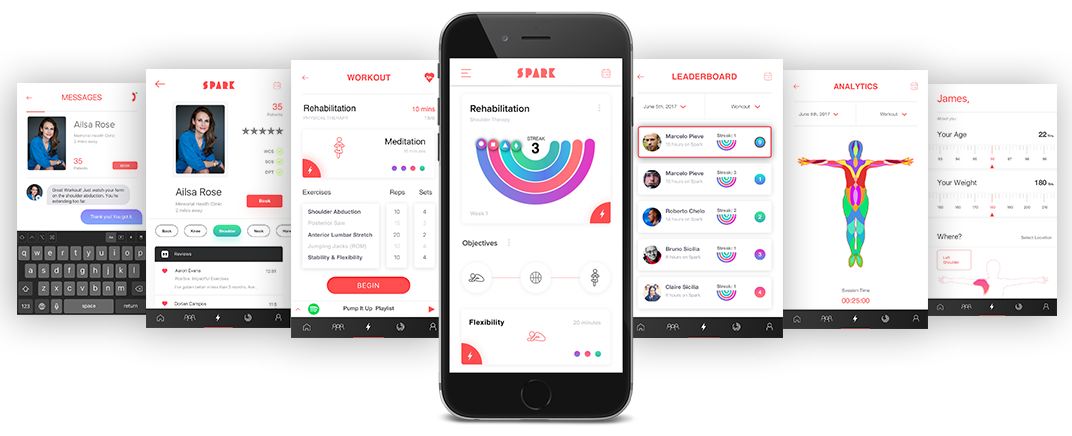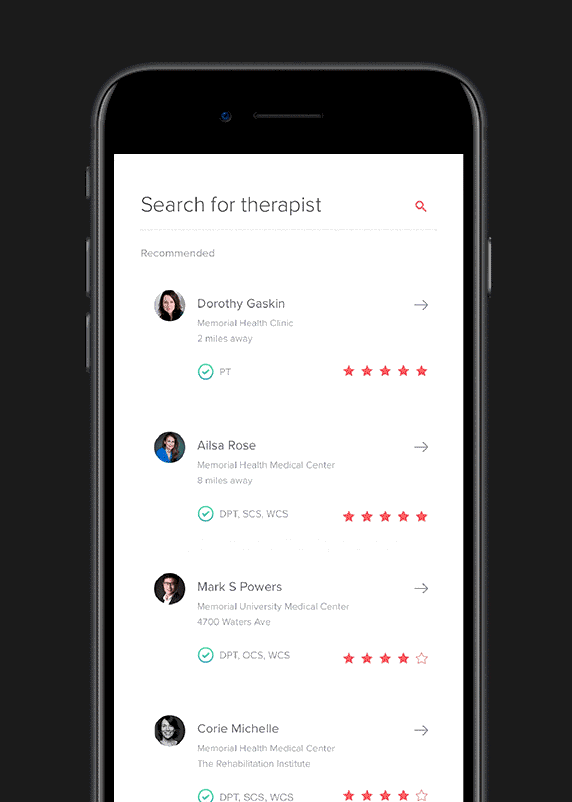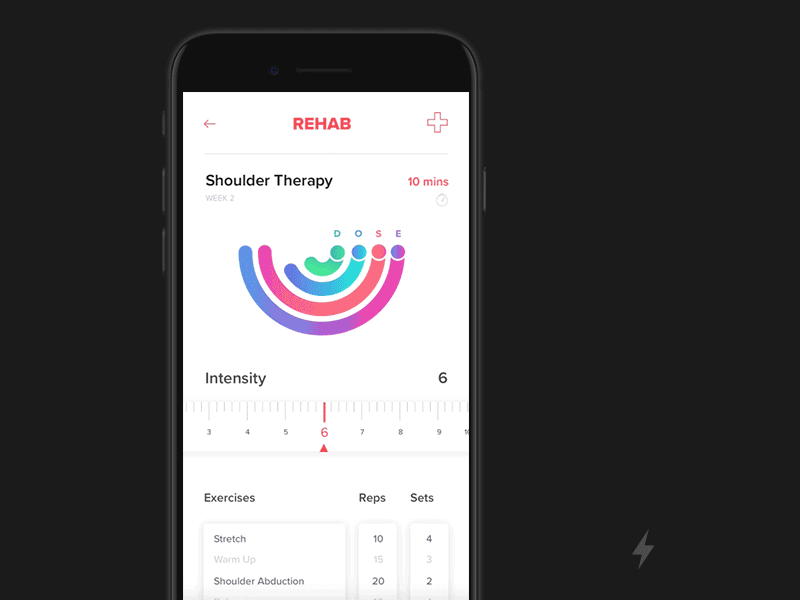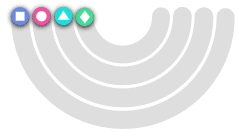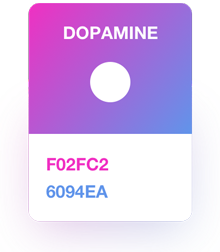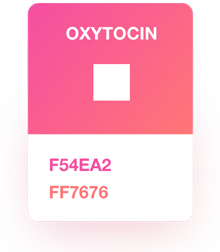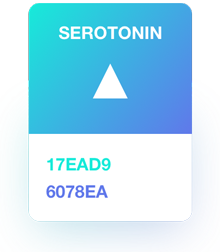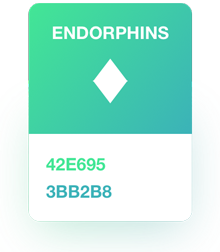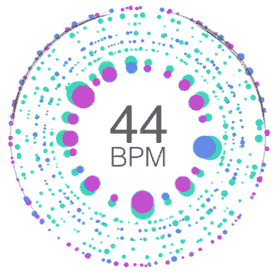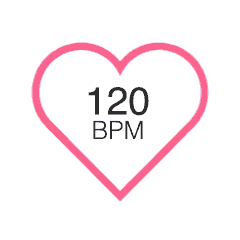
Autonomous Fitness & Rehabilitation Platform
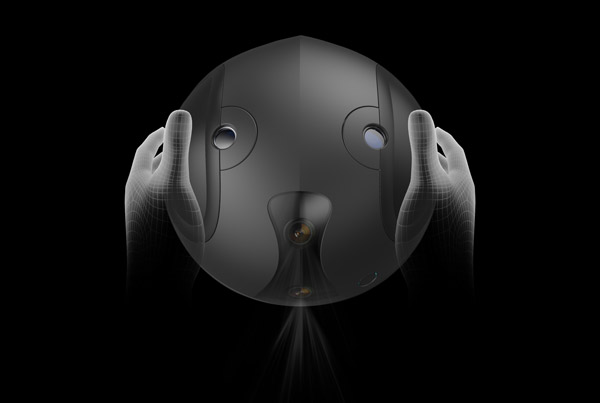
Injuries are Inevitable.
Physical Therapy is Disengaging,
Inefficient &
Inconvenient.
Each year, 50% of people over the age of 18 develop a musculoskeletal injury lasting over 3 months. People aren't recovering from their injuries because they simply abandon treatment. Spark helps users realize their progress while engaging them in a healthier lifestyle mentally and physically.

An insightful, accessible,
& motivational approach to physical therapy begins in the patient's preferred environment.
Using a combination of two intelligent projectors and a 3D infrared sensor,
Spark overlays interactive physical therapy exercises tailored to the user's injury, progress, & preferences.
Overtime, patients provide real-time feedback about their pain tolerance and exertion levels throughout each exercise, allowing the system to develop more effective treatment programs.
Find A Therapist | Workout Selection | Progress Analysis
Doctors cannot treat pain based on medical tests alone.
Communication is vital to pain management.
Connect with your therapist.
Search for a therapist specializing in treatments for your injury.
Read reviews & communicate with therapists instantly via native messenger.

Objectives
User's are prompted to select 3 activities in their life that they aim to improve with rehabilitation. By setting targets and rating themselves daily on a subjective scale of 1-10 it helps the patient and therapist communicate achievement on a mental and physical level.
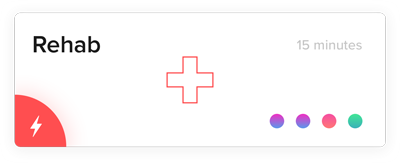
Workout Selection
A flexible approach to PT allowing the user to select from adaptable workouts designated for specific injuries. Spark learns from completion efficiency & endurance measurements to deliver personalized workouts.
PERSONALIZED
AVATAR
Start at your level in the recovery process.
Treatment begins with a physical evaluation by a therapist where they perform baseline tests recorded by Spark, later integrated into the personalized avatar and user profile.
How might we utilize brain chemistry to guide the user's experience?
Injuries trigger negative reactions in the brain.
Pain begins a physical sensation, but intensifies when thought about.
The human brain can release 4 feel-good chemicals
in reaction to perceived positive experiences.
A new measurement to track progress,
your daily dose.

Dopamine
Motivation Reward Stimulation Performance
The brain releases dopamine during task-based interactions—it’s immediate and fleeting. Dopamine is released when achieving incremental goals, gamification can be used as a reward system for motivated behaviors.
Dopamine can be a key factor in focusing the users attention whether it's a pop-up message to tell alert them of an error or an indicator that guides you to push further.
Physical therapy can be monotonous and the exercises can become complex and confusing, leaving the patient unmotivated and without direction.
Guiding the user with visual stimulation through each exercise, teaching by showing and simplifying the process to a step-by-step approach rewarding them for completing each step correctly, motivating them to achieve more.

Oxytocin
Trust Group Connection Empathy
The brain releases Oxytocin in experiences associated with trust, friendship and connection. Also known as the "love drug" because when you hug someone or feel a sense of belonging your brain reacts with Oxytocin.
Doctors cannot treat pain based on medical tests alone, communication is vital to pain management.
The relationship between therapist and patient is much more than a physical transaction of diagnostics and data plugged into an algorithm that outputs the perfect treatment plan. The emotional connection is an essential element of efficient recovery.
Trust is a motivating factor. Asking people to follow a routine that will cause them discomfort in belief that will make them recover faster requires empathy.
Patients can feel disconnected because of their injuries. Spark brings together patients with similar injuries in the recovery process utilizing leaderboards, streaks, and communication to motivate them to stick to their routine while giving them a platform to ask questions and share insights. The goal is to create a bond, a team mentality helping patients trust the process.
Avatars help humanize interactions and make the experience less routine adding comfort to social bonding.

Serotonin
Realization Progress Goal Value
The brain releases Serotonin at times of fulfillment. It is the long-term feeling of pride, triggered by the process of working toward a goal and finding real lasting value in your actions.
Serotonin and is a long lasting feeling deployed in feats of accomplishment after a tireless workout. It is important to maximize opportunity for the patient to feel this pride. By design, an emphasis is placed on visualization of progress to help people realize their success, pushing them to maintain participation in treatment.
Setting goals and working towards them is a crucial part of catalyzing this neurotransmitter. It is important that the patient has their input on what their milestones are and not just therapist. Everyone has their reasons for participating in physical therapy. We want to prompt the user to isolate those reasons and to monitor their improvements on a subjective scale. It gives them a daily measurement of how their perseverance is affecting their life and also gives the therapist a more thorough understanding of how the patient is reacting to the treatment.

Endorphins
Relief Exertion Challenge Drive
The brain releases Endorphins during physical activity. It is widely known for the "runner's high" but most importantly it induces a sensation that can mask pain.
Pain is the most outstanding setback for motivation and progress in physical therapy. It affects the patient at an emotional and physical level. If we are able to increase the production of Endorphins throughout the workout the patient can potentially participate more efficiently. Aerobic exercises increase the production of Endorphins and it doesn't have to be heavy physical exertion that activates it.
Exercising with a partner increases production and tolerance to pain better than working out alone. By leveraging an online community of users they can complete therapy in real-time with teammates across the nation. Endorphins are released even just by encouraging others and cheering them on without any physical participation.
We wanted to educate our design decisions
based on the part of the brain being stimulated.
A drug-free stress reducer and mood regulator that increases the brains production of Dopamine, Serotonin, and Endorphins.
Resonant breathing involves rhythmic deep breathing at a specific rate of inhalation and exhalation. As you inhale, your heart rate speeds up, and as you exhale, your heart rate slows down.
Breathing correctly during stretching improves flexibility and increases range of motion by relaxing the muscles on the inhale and exhale.
By breathing and holding the stretch you train your muscles to tolerate a deeper stretch before your stretch reflex kicks in.
The stretch reflex is controlled by nerves to protect muscles from damage of over stimulation but it can be trained to react slower with breathing patterns.
Prototyping Challenge
Developing binary 2D interfaces projected simultaneously into a 3D environment, intertwining the principles of motion with animation techniques simulating human movement.
It's one thing to sketch ideas and visualize them in wireframes. It's another to bring ideas to life, see their nuances and then you can truly test their effectiveness.
As ideas developed we needed a way to validate them without all the necessary equipment. Photoshop mockups could only take it so far, we needed to understand how the interface on the floor would harmonize with the design projected on the wall. Prototyping tools and testing theories became our method for authentication.
Research and trials finally quantified into physical therapy exercises that were choreographed for the motion capture studio. After calibration with 8 Vicon cameras and 56 infrared markers, these exercises were performed, recorded and rigged to the virtual skeleton of a weighted 3D model. This animated avatar completed the wall interface and allowed us to test the impact of synchronized projection on two surfaces.
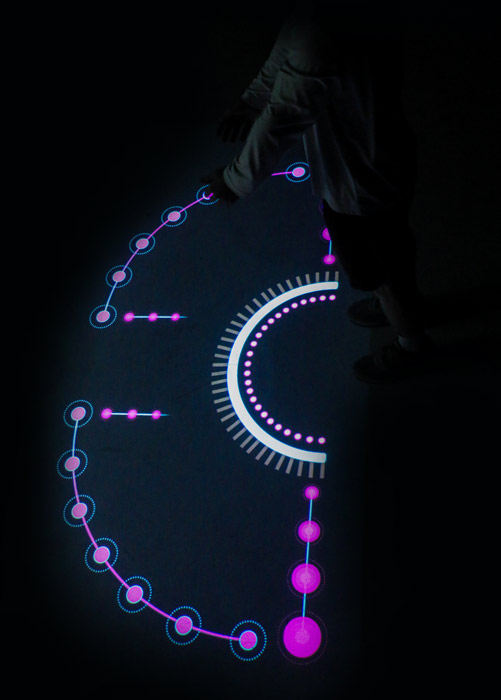

PROCESS
A look Inside my sketchbook and the obsession that became Spark.

